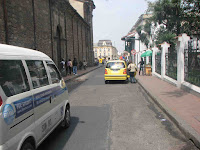 |
| An impossible scene on a normal day: A bicyclist has the whole street to himself in the Santa Fe neighborhood. |
Today was Bogotá's annual
Car-Free Day, when privately-owned cars - but not taxis, buses, work or official vehicles - are banned from the streets.
 |
This block in La Candelaria
is normally blocked with cars
parked against the sidewalk. |
The decade-old event begun by Mayor Enrique Peñalosa is intended to get auto-addicts thinking about alternative ways to get around, such as bikes and mass transit. At that, it's only a partial success, since many car users simply postpone trips to the next day. Commerce and activity generally declined today. I saw fewer street merchants and the public markets were quieter.
 |
'This Thursday Feb. 2
the city takes a deep
breath thanks to
Car-Free Day.' |
But I did see more bicyclists out today, as well as many more motorcycles. Traffic in general was down, making the city peacefuler, a bit less polluted and easier to navigate thru.
The Car-Free Day riles many auto addicted bogotanos, who have so internalized traffic jams that they take them for granted instead of seeing them as the urban blights they are. But hopefully perhaps it also opens a few people's minds.
However, to really change people's habits, we'd need both more frequent Car-Free Days and longer periods without cars. Those things aren't likely to come soon. But Mayor Gustavo Petro's plan to create a congestion fee for private car use just might accomplish something similar.
Experts from the
National University reported that sulphur and ozone
air pollutantion did not decline significantly during the Car-Free Day - principally because many of Bogotá's
buses are decades old. I'd say, rather, blame it on the pollution - whether the vehicles are new or old.
"In 12 years of reflection with Car-Free Day, today we haven't taken a single action which contributes to solve these transit problems which burden the city," said the director of the Observatory on Logistics and Transit of the Center for Development Research at the National University, who has the notable name of Jose Stalin Rojas.
Sr. Rojas is exaggerating, at least a bit - if not for the TransMilenio express bus system and the Pico y Placa rule the city would be even worse. Let's hope that new mayor Gustavo Petro does bring some real changes, including a congestion charge and the
Integrated Public Transit System (SITP).
 |
On a normal afternoon, this intersection is in gridlock. Today, the skateboarders and pedestrians are in the clear.
 |
| Here's the same spot on a normal day. Does this make any transit sense? |
|
 |
| And this avenue near the Universidad Central normally is a traffic jam every evening. Today, things were moving. |
 |
| Impossible on an ordinary afternoon, workers roll a cart carrying lumber down a La Candelaria street. |
 |
| 'Fewer cars, more clean air' says this bus stop billboard. |
 |
| The Gran Estacion shopping mall got into it with this newspaper ad - which offers to refund part of shoppers' taxi fares. How's that for logical? |
 |
| Ceramic floormaker Alfa got into things with this ad in El Tiempo urging people to 'Give some fresh air to your house with Alfa...' |
 |
| but alongside Alfa's ad was one selling cars... |
 |
| It was not a motorcycle-free day. |
 |
| Or a pollution-free day. Note the grey sky. |
 |
| The red light district still had some activity. |
 |
| Normally, the Palo Quemao Market's parking lot is crowded at mid-day. |
 |
| Today, workers played soccer in the market's parking lot. |
 |
| Waiting in a crowded TM station. |
 |
| Zorreros, or horsecarts, were not banned. |
Related Posts:
By Mike Ceaser, of
Bogotá Bike Tours
























No comments:
Post a Comment